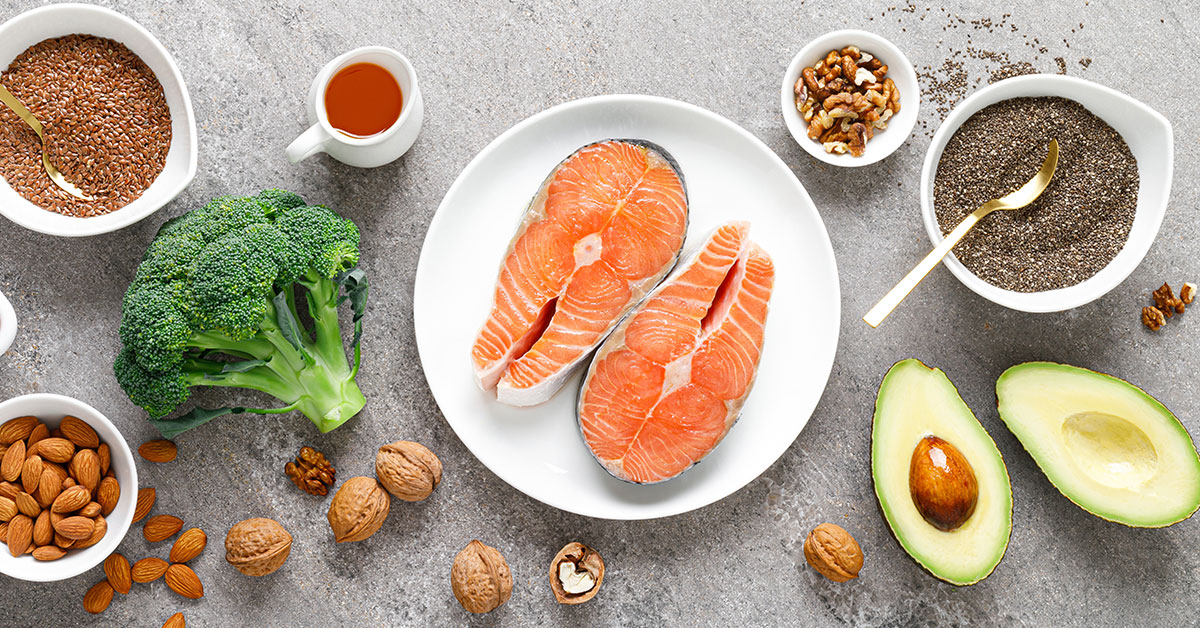





Making mindful decisions about the foods you eat, and when you eat them, builds the foundation for overall health. Neurologist Dr. Dale Bredesen developed KetoFLEX 12/3 as a guideline for healthy eating practices to reduce inflammation and promote brain function, backed by research. Continue reading to learn what is the Bredesen Diet and how to implement it in your life.
When you think of the average American diet, cheeseburgers, french fries, and fried chicken probably come to mind.
Although what people eat varies around the world, much of the typical diet consists of far too many refined carbohydrates, added sugars, red meat, antibiotic and hormone laden dairy products, processed foods, and calories. These foods can cause inflammation in the body, especially disruptive to brain health.
The good news: lifestyle changes today can prevent diseases tomorrow.
Thanks to new research, we can better understand how the body processes food and practice healthier eating habits based on science. In his book, The End of Alzheimer’s, neurologist Dr. Dale Bredesen explores the impact of different nutritional patterns on health. Early results from a successful clinical trial found that reaching a state of ketosis provides optimal health results.
Ketosis happens when your body uses dietary fat and breaks down stored fat as its primary source of fuel. It’s a metabolic state created when you consume generous amounts of healthy fat and low amounts of carbohydrates.
After observing thousands of participants, Dr. Bredesen developed KetoFLEX 12/3, a mildly ketogenic, plant-rich, highly nutritive diet combined with a minimum 12-hour fast (including 3 hours before bed).
Consuming a high amount of carbohydrates and saturated fats with low fiber intake can lead to inflammation and potential insulin resistance. Switching from carb-based metabolism to healthy-fat–based metabolism, achieved through KetoFLEX 12/3, results in the healthier metabolic state of ketosis.
Health benefits of the Breseden KetoFLEX 12/3 diet include:
Like a car engine, your body needs fuel to run. Putting high octane fuel in your car will help it run smoother and get better gas mileage. Similarly, putting nutrient-dense foods into your body will help it function better. Follow these recommendations from the Bredesen Diet to fuel your body:
A study found that processed foods with added ingredients, like baked goods, crackers, frozen dinners, breakfast cereals, or candy, can have negative health effects. Instead, KetoFLEX 12/3 recommends eating foods closest to their natural state, like fresh produce, seafood, pastured eggs, poultry, and meats from local farms.
A 90-day clinical trial found that supplementing your diet with healthy nutrients such as ginkgo leaf extract, phosphatidylserine, and turmeric promotes brain function.
Glycemic index classifies carbohydrates and measures their potential to raise blood sugar and how quickly they raise your blood sugar. Not all carbs are created equal: Nutritionists recommend eating foods with a lower glycemic index, like non-starchy vegetables, which cause a slower and lower rise in blood sugar. Avoid simple carbohydrates, like soda and dessert, with a high glycemic index.
The Ikaria Study examined one of the healthiest, longest-living communities in the world on an island in Greece. Their secret: Lots of healthy fats, such as olive oil, avocados, nuts, and seeds, key staples of the Mediterranean and Bredesen diet.
Fruit juices tend to have high levels of concentrated sugar and calories. Choose low glycemic whole fruit instead, which has more fiber and less sugar content. Berries, in particular, have neuroprotective properties.
In his book, The End of Alzheimer’s, Dr. Bredesen writes, “Go crazy in the produce aisle or preferably in your garden or local farmer’s market.” The Bredesen Diet recommends 6-9 cups of non-starchy vegetables, like cruciferous and leafy greens per day, gradually increasing the amount. You can also enjoy healthy herbs, spices, and teas, like green tea or matcha.
Certain animal products cause inflammation. Dr. Bredesen recommends prioritizing animal protein rich in docosahexaenoic acid (DHA), found in low mercury, seafood including salmon, mussels, oysters, and snow crab. Foods with choline, like eggs, liver, and grass-fed beef, also support overall health, especially memory.
Support brain health with Daily Essentials multivitamin, which contains unique brain health ingredients, including choline, to boost memory, mental energy, and cognitive function.*
A study found that foods cooked at high temperatures tend to contain harmful advanced glycation end products (AGEs), which could increase the risk of cognitive disorders.
The Bredesen Diet recommends gradually introducing prebiotic foods such as mushrooms, jicama, and leeks as well as probiotic foods with live active cultures such as sauerkraut, kimchi, sour pickles, miso soup, and low-sugar kombucha, to improve gut health. Colored tubers and legumes are important resistant starches with healthy gut-boosting benefits.
Fish and seafood provide a great source of omega-3s, which can help reduce inflammation. Just make sure to avoid fish that tend to have high mercury levels. Refer to the acronym SMASH (salmon, mackerel, anchovies, sardines, and herring) for the safest fish to eat.
A test for sensitivities will reveal foods contributing to leaky gut or inflammation and ingredients you should eliminate from your diet.
Follow these tips to help the transition into a Bredesen Diet and begin the changes toward a healthy lifestyle:
Take exogenous ketones like MCT oil, ketone salts, or esters when initially making the transition into ketosis. This supplement helps combat some of the energy dips you may feel when initially changing your diet.
Invest in a ketone meter to track ketone levels in the blood. The Bredesen Protocol recommends levels of beta hydroxybutyrate from 0.5 mmol/L to 4 mmol/L, which indicates a state of mild ketosis.
Combine the Bredesen Diet with lifestyle changes like optimized sleep, physical activity, stress management, and supplementation for best results (for personalized recommendations, check out Apollo Health).
Make small changes, one at a time. Commit to incremental changes that you’ll actually stick to, like cooking healthy recipes weekly or reducing sugary foods.
Start early—prevention is best. Research has shown that a healthy lifestyle early in life can have long-term benefits to prevent cognitive decline.
Follow along with our recipe guide, Food For Thought: Recipes for Better Brain Health.
Making major lifestyle changes might feel overwhelming at first. But, these adjustments to follow the recommendations researched by Dr. Bredesen have tremendous benefits to promote brain function and overall well-being. Take charge of your health. Learn more about the pros and cons of a keto diet for better brain health.
Take advantage of our hassle-free monthly auto-ship program to ensure that you never go a day without your favorite brain boosting NeuroQ formula. You can cancel your monthly auto-ship at any time.
As a member you can expect: